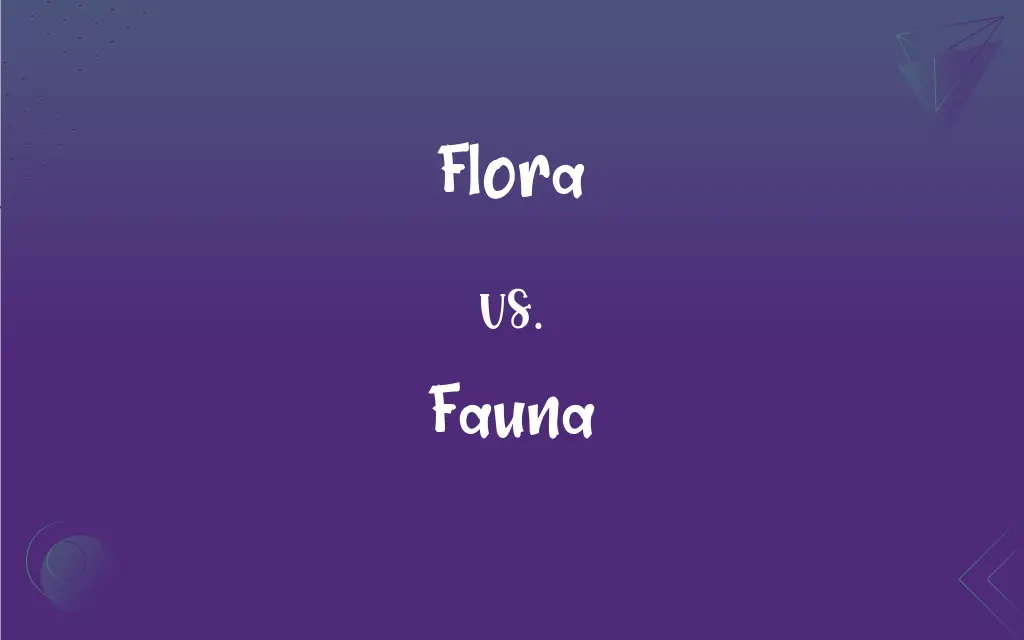Flora vs. Fauna: What's the Difference?
Edited by Janet White || By Harlon Moss || Updated on October 12, 2023
Flora refers to plant life, while fauna refers to animal life, typically in a particular environment or time period.

Key Differences
Flora encompasses the vast world of plants in various environments and contexts. This term refers to all forms of plant life existing in a particular region, period, or environment. Often, scientists and researchers explore the unique flora of different ecological regions, identifying plants, trees, and flowers that are indigenous and perhaps even endemic to certain areas. Each piece of flora, whether it be a tree, moss, or a blooming flower, contributes to the overall ecosystem, offering resources, and serving specific roles, such as providing oxygen or serving as food and shelter for various fauna.
Fauna pertains to all of the animal life present in a particular region or time. Every animal, from insects to mammals, is considered part of the fauna of their respective regions or periods. Fauna isn’t merely restricted to wild animals; it also includes domesticated species and organisms living in every kind of environment, such as forests, deserts, and underwater ecosystems. The characteristics, behaviors, and adaptive strategies of fauna are diverse, influenced heavily by the flora and geological characteristics of their environment.
The symbiotic relationship between flora and fauna is vital for sustaining life on Earth. Flora, through processes like photosynthesis, produces oxygen, which is essential for the survival of most fauna. Additionally, plants often provide food, shelter, and sometimes even camouflage for various animal species. Fauna, in return, can often aid the reproduction of plants through pollination, spread their seeds, and contribute to the nutrient cycle through waste.
The study and documentation of both flora and fauna have been pivotal in understanding ecosystems. Taxonomy, conservation efforts, and environmental policies hinge greatly on the comprehensive study of flora and fauna. Various species of both plants and animals are cataloged, studied, and sometimes preserved to understand their attributes, benefits, risks, and the roles they play in their respective ecosystems. Studying shifts and changes in flora and fauna across different regions help scientists to understand climate change, ecological imbalances, and the impact of human activities on various ecosystems.
Comparison Chart
Definition
Pertains to all plant life in a region.
Pertains to all animal life in a region.
ADVERTISEMENT
Contribution
Produces oxygen through photosynthesis.
Often aids in pollination for plants.
Dependency
Generally relies on sunlight and soil.
Often depends on plants for food and shelter.
Study Branch
Botany
Zoology
Examples
Trees, flowers, grasses.
Mammals, birds, reptiles.
Flora and Fauna Definitions
Flora
In medical contexts, flora can describe microorganisms inhabiting an organism.
A healthy gut flora is crucial for overall well-being and digestion.
ADVERTISEMENT
Fauna
Fauna refers to all of the animal life in a particular region or era.
The fauna of Australia includes unique species like kangaroos and koalas.
Flora
Flora encompasses all plant life in a particular geographical region or time.
The flora of the Amazon rainforest is incredibly diverse and complex.
Fauna
In literature, "fauna" may symbolize the collective animal characters or entities.
The fauna in the Jungle Book by Rudyard Kipling showcases various animal behaviors.
Flora
Flora can refer to a publication discussing or illustrating plants.
Flora of North America provides extensive details about the continent's plants.
Fauna
The term "fauna" might be used to describe the collective animals of a specific class or type in a region.
The avian fauna of North America is varied and includes species like eagles, sparrows, and hummingbirds.
Flora
In mythology, Flora is the goddess of flowers and the season of spring.
Many Renaissance artists depicted Flora, symbolizing nature and rebirth.
Fauna
Fauna also indicates a catalog or a book which discusses or illustrates the animal species in a particular region.
The Fauna of British India includes detailed descriptions of the species found in the region.
Flora
Flora can also pertain to the plants of a particular region, habitat, or period.
The desert flora has adapted to survive in extremely arid conditions.
Fauna
In mythology and culture, fauna can represent symbols or deities associated with animals.
Fauna, in Roman mythology, was a goddess of fertility and the earth.
Flora
The goddess of flowers.
Fauna
(used with a sing. or pl. verb) Animals, especially the animals of a particular region or period, considered as a group.
Flora
(used with a sing. or pl. verb) Plants considered as a group, especially the plants of a particular country, region, or time.
Fauna
A catalog of the animals of a specific region or period.
Fauna
(uncountable) Animals considered as a group; especially those of a particular country, region, time.
The flora and fauna
Fauna
(countable) A book, cataloguing the animals of a country.
Fauna
The animals of any given area or epoch; as, the fauna of America; fossil fauna; recent fauna.
Fauna
All the animal life in a particular region
Fauna
A living organism characterized by voluntary movement
FAQs
How does flora benefit fauna?
Flora provides fauna with food, shelter, and oxygen, which are essential for survival.
Can flora and fauna refer to extinct species?
Yes, flora and fauna can refer to both existing and extinct plant and animal life.
What is fauna?
Fauna encompasses all animal life found in a specific region or time period.
Do flora and fauna refer only to native species?
No, flora and fauna refer to all species in a region, whether native or introduced.
What is marine flora?
Marine flora refers to plant life existing in oceanic and sea environments, like seaweed and algae.
Is bacteria considered flora?
In medical terms, bacteria in the human body are sometimes referred to as microbial flora.
How does fauna benefit flora?
Fauna often contributes to pollination, seed dispersion, and nutrient cycling beneficial to flora.
Which field studies fauna?
Zoology is the scientific study devoted to animal life or fauna.
What is considered terrestrial fauna?
Terrestrial fauna refers to animals that live predominantly on land, like mammals and birds.
Are domesticated animals considered fauna?
Yes, both wild and domesticated animals are categorized as fauna.
What is microfauna?
Microfauna refers to microscopic animals like protozoa.
Can the term flora be used to describe plants in a small garden?
Yes, flora can refer to plants in a specific, localized area like a garden.
Are insects a part of fauna?
Yes, insects are considered a crucial part of fauna.
Can flora refer to a single plant species?
Generally, flora refers to the collective plant life, but it can highlight specific species in context.
What studies flora?
Botany is the scientific study of plants or flora.
Can fungi be considered flora?
Traditionally, yes, though scientifically fungi are now classified in their own kingdom.
Is a fish part of the fauna?
Yes, fish are a vital part of aquatic fauna.
Can a single tree be described as flora?
While flora typically refers to collective plant life, a tree may be discussed as part of the flora in its context.
What is the flora and fauna like in a desert?
Desert flora and fauna have adapted to survive in harsh, arid conditions and might include cacti and camels.
What does flora refer to?
Flora refers to all plant life present in a particular region or time period.
About Author
Written by
Harlon MossHarlon is a seasoned quality moderator and accomplished content writer for Difference Wiki. An alumnus of the prestigious University of California, he earned his degree in Computer Science. Leveraging his academic background, Harlon brings a meticulous and informed perspective to his work, ensuring content accuracy and excellence.
Edited by
Janet WhiteJanet White has been an esteemed writer and blogger for Difference Wiki. Holding a Master's degree in Science and Medical Journalism from the prestigious Boston University, she has consistently demonstrated her expertise and passion for her field. When she's not immersed in her work, Janet relishes her time exercising, delving into a good book, and cherishing moments with friends and family.































































